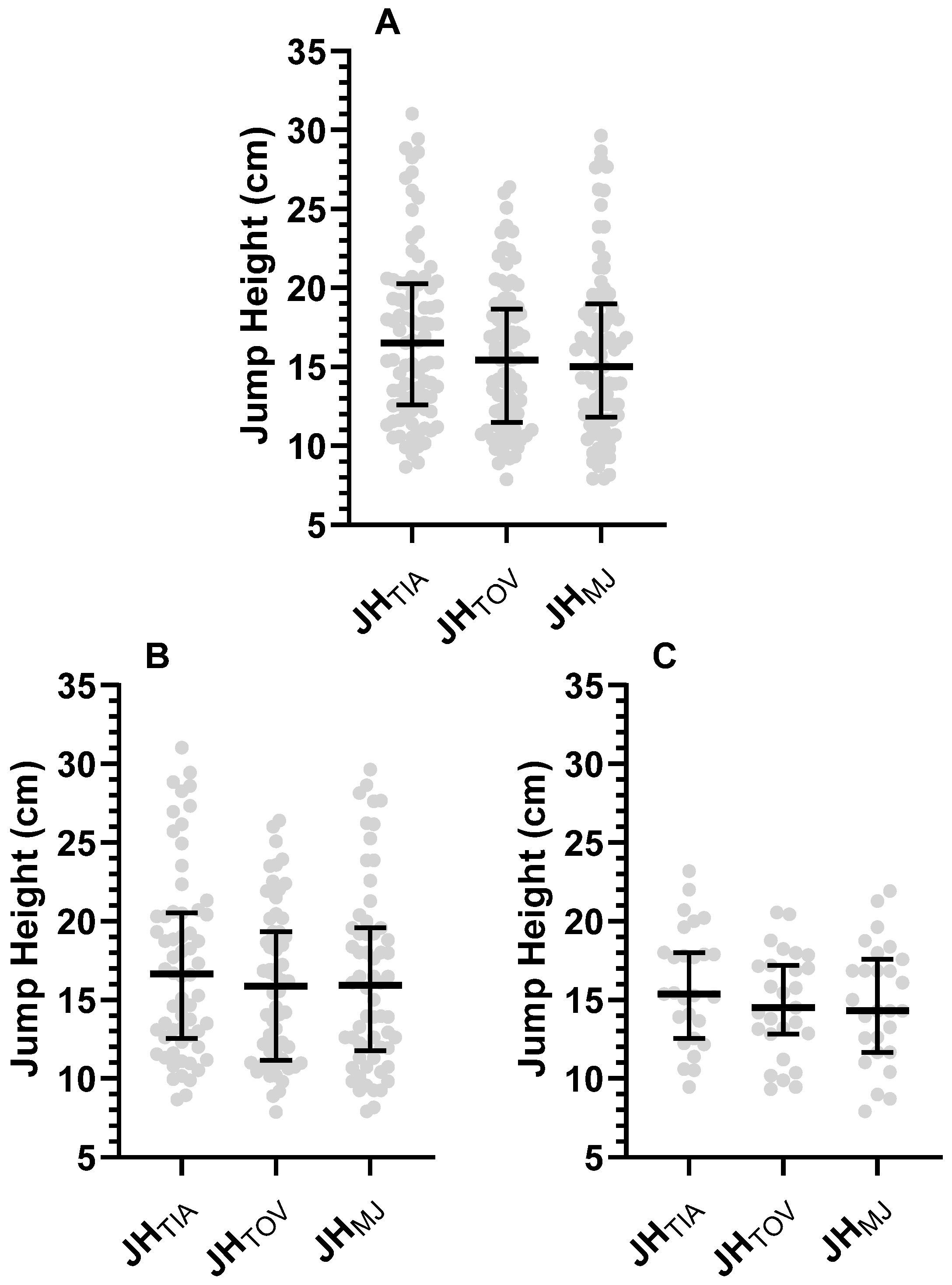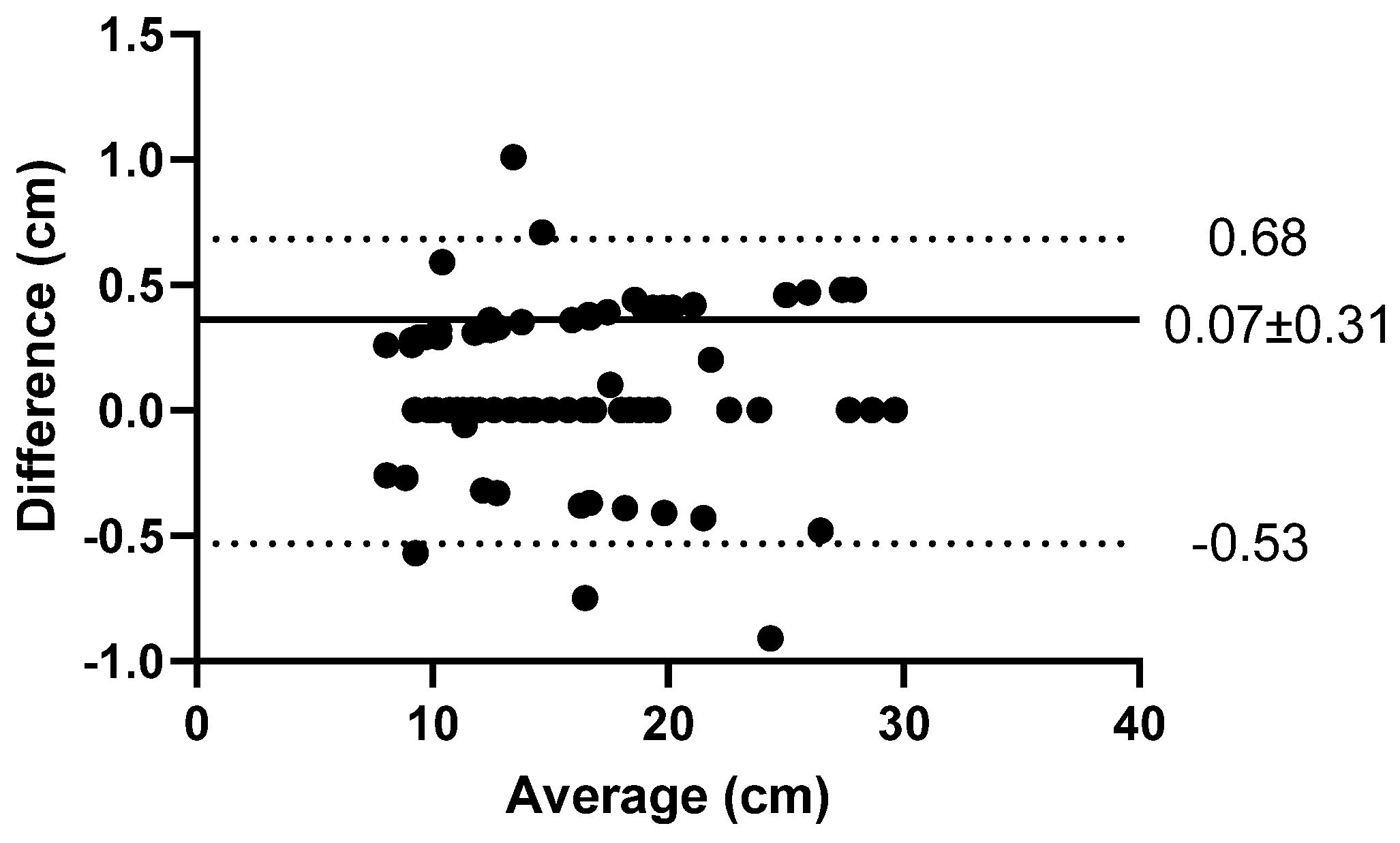Agreement between Force Platform and Smartphone Application-Derived Measures of Vertical Jump Height in Youth Grassroots Soccer Players
Abstract
1. Introduction
2. Materials and Methods
2.1. Participants
2.2. Experimental Procedures
2.3. Data and Statistical Analysis
3. Results
4. Discussion
Limitations and Future Directions
5. Conclusions
Author Contributions
Funding
Institutional Review Board Statement
Informed Consent Statement
Data Availability Statement
Conflicts of Interest
References
- Liebermann, D.G.; Katz, L. On the assessment of lower-limb muscular power capability. Isokinet. Exerc. Sci. 2003, 11, 87–94. [Google Scholar] [CrossRef]
- O’Malley, E.; Richter, C.; King, E.; Strike, S.; Moran, K.; Franklyn-Miller, A.; Moran, R. Countermovement jump and isokinetic dynamometry as measures of rehabilitation status after anterior cruciate ligament reconstruction. J. Athl. Train. 2018, 53, 687–695. [Google Scholar] [CrossRef]
- Impellizzeri, F.M.; Rampinini, E.; Maffiuletti, N.; Marcora, S.M. A vertical jump force test for assessing bilateral strength asymmetry in athletes. Med. Sci. Sports Exerc. 2007, 39, 2044–2050. [Google Scholar] [CrossRef]
- Claudino, J.G.; Cronin, J.; Mezencio, B.; McMaster, D.T.; McGuigan, M.; Tricoli, V.; Amadio, A.C.; Serrao, J.C. The countermovement jump to monitor neuromuscular status: A meta-analysis. J. Sci. Med. Sport 2017, 20, 397–402. [Google Scholar] [CrossRef]
- Petrigna, L.; Karsten, B.; Marcolin, G.; Paoli, A.; D’Antona, G.; Palma, A.; Bianco, A. A review of countermovement and squat jump testing methods in the context of public health examination in adolescence: Reliability and feasibility of current testing procedures. Front. Physiol. 2019, 10, 1384. [Google Scholar] [CrossRef] [PubMed]
- Acero, R.M.; Fernandez-del Olmo, M.; Sanchez, J.A.; Otero, X.L.; Aguado, X.; Rodriguez, F.A. Reliability of squat and countermovement jump tests in children 6 to 8 years of age. Pediatr. Exerc. Sci. 2011, 23, 151–160. [Google Scholar] [CrossRef]
- Sgro, F.; Nicolosi, S.; Schembri, R.; Pavone, M.; Lipoma, M. Assessing vertical jump developmental levels in childhood using a low-cost motion capture approach. Percept. Mot. Skills 2015, 120, 642–658. [Google Scholar] [CrossRef]
- Chan-Viquez, D.; Hasanbarani, F.; Zhang, L.; Anaby, D.; Turpin, N.A.; Lamontagne, A.; Feldman, A.G.; Levin, M.F. Development of vertical and forward jumping skills in typically developing children in the context of referent control of motor actions. Dev. Psychobiol. 2020, 62, 711–722. [Google Scholar] [CrossRef] [PubMed]
- Moir, G.; Shastri, P.; Connaboy, C. Intersession reliability of vertical jump height in women and men. J. Strength Cond. Res. 2008, 22, 1779–1784. [Google Scholar] [CrossRef] [PubMed]
- Balsalobre-Fernández, C.; Tejero-González, C.M.; del Campo-Vecino, J.; Bavaresco, N. The concurrent validity and reliability of a low-cost, high-speed camera-based method for measuring the flight time of vertical jumps. J. Strength Cond. Res. 2014, 28, 528–533. [Google Scholar] [CrossRef] [PubMed]
- Glatthorn, J.F.; Gouge, S.; Nussbaumer, S.; Stauffacher, S.; Impellizzeri, F.M.; Maffiuletti, N.A. Validity and reliability of optojump photoelectric cells for estimating vertical jump height. J. Strength Cond. Res. 2011, 25, 556–560. [Google Scholar] [CrossRef]
- Monnet, T.; Decatoire, A.; Lacouture, P. Comparison of algorithms to determine jump height and flight time from body mounted accelerometers. Sports Eng. 2014, 17, 249–259. [Google Scholar] [CrossRef]
- Sawczuk, T.; Jones, B.; Scantlebury, S.; Weakley, J.; Read, D.; Costello, N.; Darrall-Jones, J.D.; Stokes, K.; Till, K. Between-day reliability and usefulness of a fitness testing battery in youth sport athletes: Reference data for practitioners. Meas. Phys. Educ. Exerc. Sci. 2018, 22, 11–18. [Google Scholar] [CrossRef]
- Thomas, C.; Dos’Santos, T.; Comfort, P.; Jones, P.A. Between-session reliability of common strength- and power-related measures in adolescent athletes. Sports 2017, 5, 15. [Google Scholar] [CrossRef]
- Dugdale, J.H.; Arthur, C.A.; Sanders, D.; Hunter, A.M. Reliability and validity of field-based fitness tests in youth soccer players. Eur. J. Sport Sci. 2019, 19, 745–756. [Google Scholar] [CrossRef] [PubMed]
- Moir, G.L. Three different methods of calculating vertical jump height from force platform data in men and women. Meas. Phys. Educ. Exerc. Sci. 2008, 12, 207–218. [Google Scholar] [CrossRef]
- Balsalobre-Fernandez, C.; Glaister, M.; Lockey, R.A. The validity and reliability of an iphone app for measuring vertical jump performance. J. Sports Sci. 2015, 33, 1574–1579. [Google Scholar] [CrossRef] [PubMed]
- Carlos-Vivas, J.; Martin-Martinez, J.P.; Hernandez-Mocholi, M.A.; Perez-Gomez, J. Validation of the iphone app using the force platform to estimate vertical jump height. J. Sports Med. Phys. Fitness 2018, 58, 227–232. [Google Scholar] [CrossRef] [PubMed]
- Bogataj, S.; Pajek, M.; Hadzic, V.; Andrasic, S.; Padulo, J.; Trajkovic, N. Validity, reliability, and usefulness of my jump 2 app for measuring vertical jump in primary school children. Int. J. Environ. Res. Public Health 2020, 17, 3708. [Google Scholar] [CrossRef]
- Cruvinel-Cabral, R.M.; Oliveira-Silva, I.; Medeiros, A.R.; Claudino, J.G.; Jimenez-Reyes, P.; Boullosa, D.A. The validity and reliability of the “my jump app” for measuring jump height of the elderly. PeerJ 2018, 6, e5804. [Google Scholar] [CrossRef]
- Coswig, V.; Silva, A.; Barbalho, M.; Faria, F.R.; Nogueira, C.D.; Borges, M.; Buratti, J.R.; Vieira, I.B.; Roman, F.J.L.; Gorla, J.I. Assessing the validity of the myjump2 app for measuring different jumps in professional cerebral palsy football players: An experimental study. JMIR Mhealth Uhealth 2019, 7, e11099. [Google Scholar] [CrossRef]
- Driller, M.; Tavares, F.; McMaster, D.; O’Donnell, S. Assessing a smartphone application to measure counter-movement jumps in recreational athletes. Int. J. Sports Sci. Coach. 2017, 12, 661–664. [Google Scholar] [CrossRef]
- Gallardo-Fuentes, F.; Gallardo-Fuentes, J.; Ramirez-Campillo, R.; Balsalobre-Fernandez, C.; Martinez, C.; Caniuqueo, A.; Canas, R.; Banzer, W.; Loturco, I.; Nakamura, F.Y.; et al. Intersession and intrasession reliability and validity of the my jump app for measuring different jump actions in trained male and female athletes. J. Strength Cond. Res. 2016, 30, 2049–2056. [Google Scholar] [CrossRef]
- Rogers, S.A.; Hassmén, P.; Hunter, A.; Alcock, A.; Crewe, S.T.; Strauts, J.A.; Gilleard, W.L.; Weissensteiner, J.R. The validity and reliability of the myjump2 application to assess vertical jumps in trained junior athletes. Meas. Phys. Educ. Exerc. Sci. 2019, 23, 69–77. [Google Scholar] [CrossRef]
- Xu, J.; Turner, A.; Comfort, P.; Harry, J.R.; McMahon, J.J.; Chavda, S.; Bishop, C. A systematic review of the different calculation methods for measuring jump height during the countermovement and drop jump tests. Sports Med. 2023, 53, 1055–1072. [Google Scholar] [CrossRef]
- Armada-Cortés, E.; Peláez Barrajón, J.; Benítez-Muñoz, J.A.; Navarro, E.; San Juan, A.F. Can we rely on flight time to measure jumping performance or neuromuscular fatigue-overload in professional female soccer players? J. Appl. Sci. 2020, 10, 4424. [Google Scholar] [CrossRef]
- Meylan, C.M.; Cronin, J.B.; Oliver, J.L.; Hughes, M.G.; McMaster, D. The reliability of jump kinematics and kinetics in children of different maturity status. J. Strength Cond. Res. 2012, 26, 1015–1026. [Google Scholar] [CrossRef]
- Harry, J.R.; Blinch, J.; Barker, L.A.; Krzyszkowski, J.; Chowning, L. Low-pass filter effects on metrics of countermovement vertical jump performance. J. Strength Cond. Res. 2022, 36, 1459–1467. [Google Scholar] [CrossRef]
- Lyons Donegan, M.; Eustace, S.; Morris, R.; Penny, R.; Tallis, J. The effects of soccer specific exercise on countermovement jump performance in elite youth soccer players. Children 2022, 9, 1861. [Google Scholar] [CrossRef]
- Mundy, P.D.; Lake, J.P.; Carden, P.J.; Smith, N.A.; Lauder, M.A. Agreement between the force platform method and the combined method measurements of power output during the loaded countermovement jump. Sports Biomech. 2016, 15, 23–35. [Google Scholar] [CrossRef]
- Chavda, S.; Bromley, T.; Jarvis, P.; Williams, S.; Bishop, C.; Turner, A.N.; Lake, J.P.; Mundy, P.D. Force-time characteristics of the countermovement jump: Analyzing the curve in excel. Strength Cond. J. 2018, 40, 67–77. [Google Scholar] [CrossRef]
- Ivarsson, A.; Andersen, M.B.; Johnson, U.; Lindwall, M. To adjust or not adjust: Nonparametric effect sizes, confidence intervals, and real-world meaning. J. Psychol. Sport 2013, 14, 97–102. [Google Scholar] [CrossRef]
- Cohen, J. Statistical Power Analysis for the Behavioral Sciences; Routledge: Oxfordshire, UK, 2013. [Google Scholar]
- Koo, T.K.; Li, M.Y. A guideline of selecting and reporting intraclass correlation coefficients for reliability research. J. Chiropr. Med. 2016, 15, 155–163. [Google Scholar] [CrossRef] [PubMed]
- Buchheit, M.; Lefebvre, B.; Laursen, P.B.; Ahmaidi, S. Reliability, usefulness, and validity of the 30-15 intermittent ice test in young elite ice hockey players. J. Strength Cond. Res. 2011, 25, 1457–1464. [Google Scholar] [CrossRef]
- Hopkins, W.G. Measures of reliability in sports medicine and science. Sports Med. 2000, 30, 1–15. [Google Scholar] [CrossRef]
- Giavarina, D. Understanding bland altman analysis. Biochem. Med. 2015, 25, 141–151. [Google Scholar] [CrossRef] [PubMed]
- Lesinski, M.; Schmelcher, A.; Herz, M.; Puta, C.; Gabriel, H.; Arampatzis, A.; Laube, G.; Büsch, D.; Granacher, U. Maturation-, age-, and sex-specific anthropometric and physical fitness percentiles of german elite young athletes. PLoS ONE 2020, 15, e0237423. [Google Scholar] [CrossRef]
- Lawson, C.; Eyre, E.L.J.; Tallis, J.; Duncan, M.J. Fundamental movement skill proficiency among british primary school children: Analysis at a behavioral component level. Percept. Mot. Skills 2021, 128, 625–648. [Google Scholar] [CrossRef]
- Adeyemi-Walker, L.J.; Duncan, M.; Tallis, J.; Eyre, E. Fundamental motor skills of children in deprived areas of england: A focus on age, gender and ethnicity. Children 2018, 5, 110. [Google Scholar] [CrossRef] [PubMed]
- Papaiakovou, G.; Giannakos, A.; Michailidis, C.; Patikas, D.; Bassa, E.; Kalopisis, V.; Anthrakidis, N.; Kotzamanidis, C. The effect of chronological age and gender on the development of sprint performance during childhood and puberty. J. Strength Cond. Res. 2009, 23, 2568–2573. [Google Scholar] [CrossRef]
- Harry, J.R.; Paquette, M.R.; Caia, J.; Townsend, R.J.; Weiss, L.W.; Schilling, B.K. Effects of footwear condition on maximal jumping performance. J. Strength Cond. Res. 2015, 29, 1657–1665. [Google Scholar] [CrossRef] [PubMed]
- Fousekis, K.; Tsepis, E.; Vagenas, G. Lower limb strength in professional soccer players: Profile, asymmetry, and training age. J. Sports Sci. Med. 2010, 9, 364–373. [Google Scholar] [PubMed]
- Ascenzi, G.; Ruscello, B.; Filetti, C.; Bonanno, D.; Di Salvo, V.; Nuñez, F.J.; Mendez-Villanueva, A.; Suarez-Arrones, L. Bilateral deficit and bilateral performance: Relationship with sprinting and change of direction in elite youth soccer players. Sports 2020, 8, 82. [Google Scholar] [CrossRef] [PubMed]



| CV% | SEM (cm) | ICC (95%CI) | ICC p | ||
|---|---|---|---|---|---|
| All | JHTIA vs. JHTOV | 6.6 | 1.1 | 0.955 (0.801–0.982) | <0.001 |
| JHTIA vs. JHMJ | 4.7 | 0.3 | 0.990 (0.322–0.998) | <0.001 | |
| JHTOV vs. JHMJ | 5.7 | 1.1 | 0.971 (0.956–0.981) | <0.001 | |
| Males | JHTIA vs. JHTOV | 6.8 | 1.3 | 0.956 (0.823–0.982) | <0.001 |
| JHTIA vs. JHMJ | 4.2 | 0.3 | 0.993 (0.381–0.999) | <0.001 | |
| JHTOV vs. JHMJ | 6.1 | 1.2 | 0.972 (0.952–0.983) | <0.001 | |
| Females | JHTIA vs. JHTOV | 6.0 | 0.8 | 0.945 (0.583–0.984) | <0.001 |
| JHTIA vs. JHMJ | 5.5 | 0.3 | 0.972 (0.078–0.955) | <0.001 | |
| JHTOV vs. JHMJ | 4.7 | 0.9 | 0.967 (0.928–0.985) | <0.001 |
Disclaimer/Publisher’s Note: The statements, opinions and data contained in all publications are solely those of the individual author(s) and contributor(s) and not of MDPI and/or the editor(s). MDPI and/or the editor(s) disclaim responsibility for any injury to people or property resulting from any ideas, methods, instructions or products referred to in the content. |
© 2023 by the authors. Licensee MDPI, Basel, Switzerland. This article is an open access article distributed under the terms and conditions of the Creative Commons Attribution (CC BY) license (https://creativecommons.org/licenses/by/4.0/).
Share and Cite
Tallis, J.; Morris, R.O.; Duncan, M.J.; Eyre, E.L.J.; Guimaraes-Ferreira, L. Agreement between Force Platform and Smartphone Application-Derived Measures of Vertical Jump Height in Youth Grassroots Soccer Players. Sports 2023, 11, 117. https://doi.org/10.3390/sports11060117
Tallis J, Morris RO, Duncan MJ, Eyre ELJ, Guimaraes-Ferreira L. Agreement between Force Platform and Smartphone Application-Derived Measures of Vertical Jump Height in Youth Grassroots Soccer Players. Sports. 2023; 11(6):117. https://doi.org/10.3390/sports11060117
Chicago/Turabian StyleTallis, Jason, Rhys O. Morris, Michael J. Duncan, Emma L. J. Eyre, and Lucas Guimaraes-Ferreira. 2023. "Agreement between Force Platform and Smartphone Application-Derived Measures of Vertical Jump Height in Youth Grassroots Soccer Players" Sports 11, no. 6: 117. https://doi.org/10.3390/sports11060117
APA StyleTallis, J., Morris, R. O., Duncan, M. J., Eyre, E. L. J., & Guimaraes-Ferreira, L. (2023). Agreement between Force Platform and Smartphone Application-Derived Measures of Vertical Jump Height in Youth Grassroots Soccer Players. Sports, 11(6), 117. https://doi.org/10.3390/sports11060117







